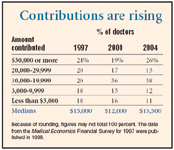Article
Financial Survey: Retirement plans are lagging
Physicians need to boost growth if they want to live the good life after practice ends. See how your efforts stack up to your colleagues'.

However, financial adviser Sherman Doll, CPA, of Capital Performance Advisors, Walnut Creek, CA, observes, "Most physicians underestimate the amount they need to save each year to provide an adequate retirement. Saving only $16,000 a year toward retirement just won't be enough. Most of the projections we run for physicians show they'll need about $1 million to $2 million of retirement assets, excluding their homes, at age 60."
401(k)s are the most popular plan

Doctors' participation in profit-sharing plans dwindled slightly, from 30 percent in 2000 to 29 percent last year. One-third of solo practitioners have profit-sharing plans, as do 49 percent of doctors who are part owners. Only 14 percent of non-owner doctors have them.

Other defined-contribution plans, such as money-purchase plans, had the same $41,000 annual contribution limit in 2004. Defined-benefit plans are subject to different limits; they can accumulate enough funds to finance a pre-set yearly pension equal to 100 percent of average salary, based on the highest earnings over three consecutive years. In 2004 it was possible to fund a maximum annual defined benefit of $165,000.





